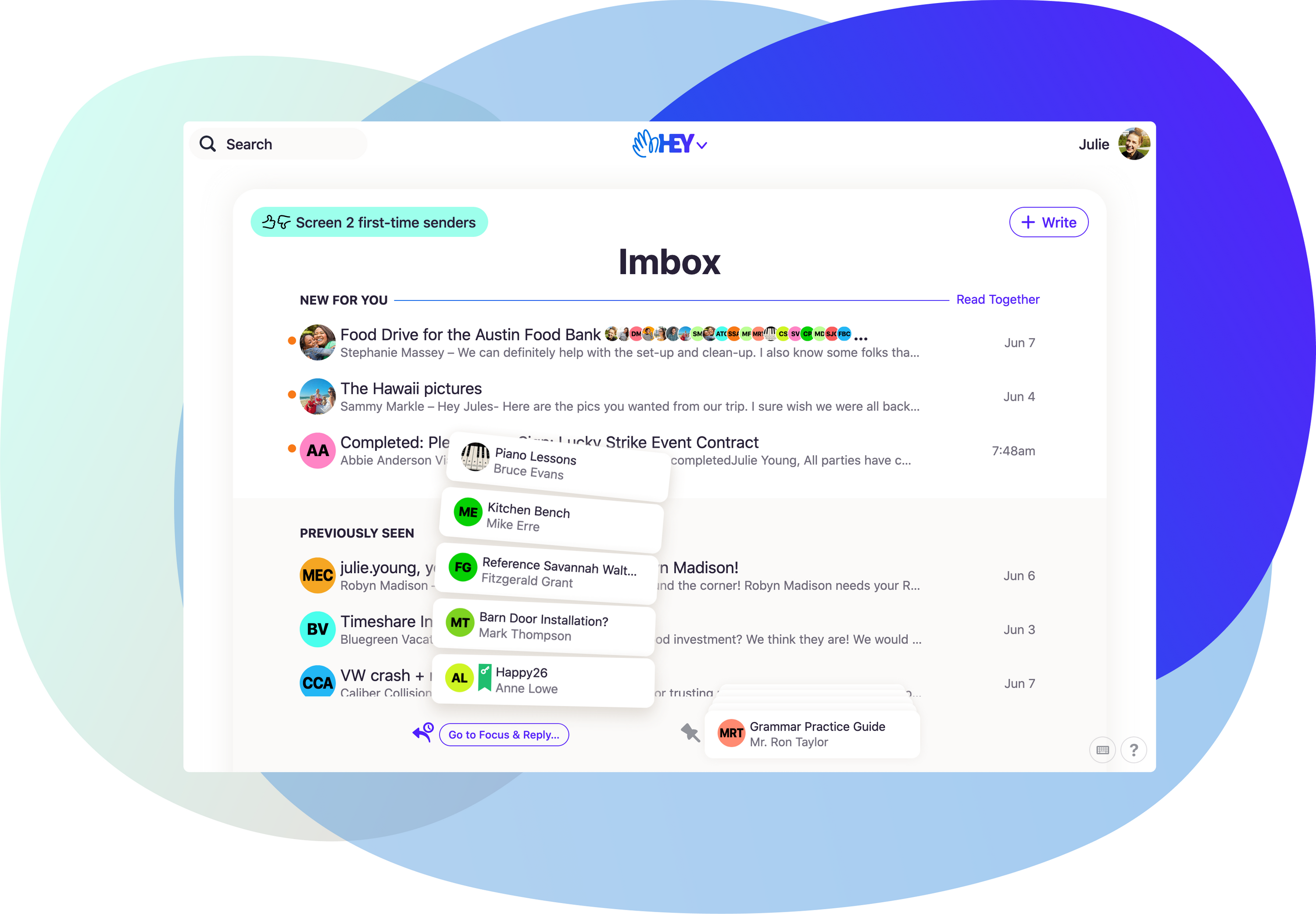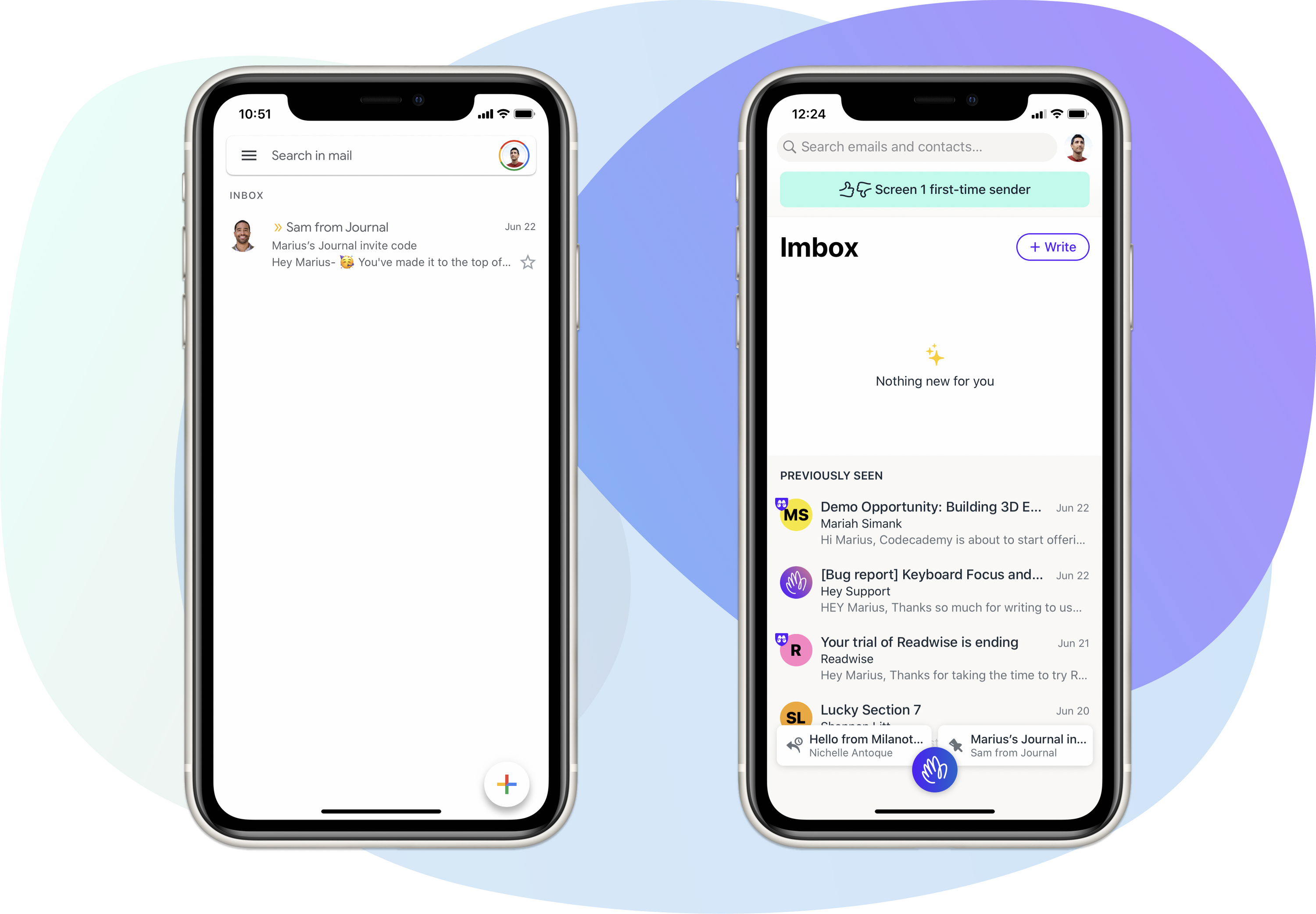Hey is Not for Me
I’m sad to admit that Hey may not be a good fit for me—but it probably is for you!

Now that the initial hype and honeymoon period has died down, I’m sad to admit that the more time I spend with it, the less I like Hey. It’s not because of any particular failing on their part—the app and service work exactly as advertised.
Unfortunately, what it offers is a workflow that is just plain slower and less efficient than my previous email solution, and while it has many concrete philosophical benefits, those come at the expense of added stress and uncertainty.
Redundant Categories
In adopting Hey, my formerly-unified inbox is now an elaborate three-view environment with a filtration system in front of it to catch unwanted new senders. And don’t get me wrong: I like the concept of the Screener.
But it turns out that I get so few emails—and so few of those are “unwanted”—that the screener is operating as a redundant inbox. It’s a feature I admire in theory but that’s actively detrimental to my email processing speed.
As for Feed and Paper Trail, my system doesn’t allow for emails that I receive but don’t need to read. If I don’t need to read it, I don’t need to receive it. Pretty simple.
I don’t want sales emails from retailers, I don’t want anything I can get directly from an app notification, and the newsletters I subscribe to (fewer than five) I subscribe to because I want to read them.
What Hey considers transactional emails destined for the Paper Trail are emails I want to see, not hide away. For example, if I get an alert about an account login, I want to see that immediately. If it was me, I can quickly delete it and move on; if it wasn’t me, I need to take action right away, not sit around in a vulnerable state until I decide to browse the Paper Trail again.
And yes, I could enable notifications for that sender…but only after the first time an email like that showed up. They’re not all that frequent, and since there’s no global notification system, my only possible approach would be opening the app obsessively for months until I’m convinced that all likely senders have sent me an email so that I can enable notifications for them.
I could instead opt to send all emails to the Imbox and just not use the Feed or Paper Trail, but since those views can’t be turned off it’s like having permanent clutter in my system. Plus, that wouldn’t remove the extra Screener layer, and it still wouldn’t give me the ability to be notified for the presence of new messages.
No-tifications
Even after a week of enabling notifications for senders, I still have no idea when I’m caught up with my emails.
I get notified for new messages from contacts I’ve enabled notifications for and from imported contacts, but I have no clue when I have new emails to look at in the Screener or Imbox just by looking at the app icon.
I understand that most people have the opposite problem: high email volume where they don’t want to be notified for everything. But in my case, I’ve spent years ensuring that almost everything that hits my inbox is actionable and desirable.
With Hey, I have to open the app and flip through the panes multiple additional times each day. And when I’m not looking at it, I don’t know whether my inbox is up to date because Hey isn’t designed to offer that information at a glance.
The Two-App Dilemma
Let’s call those notification issues a temporary set of problems. I could patiently spend my time training the system to notify me until I eventually get back to the basic peace of mind I had before.
But even if I get Hey to that point, I still have to use two apps for email going forward—forever.
Why? No import.
My entire email history exists outside of Hey’s walls, with no way of bringing it in, which means that any time I need to retrieve an email older than last week, I have to go back to Gmail.
This is like switching family doctors without being able to bring your medical records with you—“Fresh start!” doesn’t exactly cut it.
And it’s particularly baffling because Hey is more than happy to let you export your mail data in industry-standard formats…if it’s so easy to get out, why isn’t it possible to bring the equivalent data in?
Gmail is, unsurprisingly, flawless at finding emails and is single-handedly responsible for me ditching my previous habits involving email folders and rules.
My ideal system of organization is good search because it means finding something is always a one-step process.
I never click and scroll to find emails. I believe others when they tell me there are emails they could only find because of their elaborate filing system of labels and folders, but my reaction is to smile and shrug. I guess my email retrieval needs are incredibly basic, or I’m just lucky and Gmail’s search has never failed to produce what I’m looking for.
This being the case, Hey not only slows down my processing of email, it also requires me to maintain a second app just to refer back to previous correspondence.
Clutter
Furthermore, the absence of a true archive means that Hey will always look more cluttered than my Gmail inbox did.
Since I don’t keep emails in the inbox once I’ve dealt with them, my inbox is usually a fresh and clean place with only active items waiting for me.
In Hey, my email history is always visible, even though I don’t want it to be. I don’t know about you, but once I’ve finished with an email, I don’t want to look at it anymore unless there’s been a reply or I have to refer back to something (via search).
In Gmail, when I open the inbox I see only emails that I need to do something with. In Hey, I see those emails, plus the emails I’ve already dealt with, plus the emails I’ve decided I’ll reply to later, plus the emails I’ve set aside, and sometimes even a button letting me know I have other emails to do something about in the Screener…how exactly is this more tidy and peaceful?
 These are identical email states in Gmail (left) and Hey (right).
These are identical email states in Gmail (left) and Hey (right).
To give a more specific anecdotal reason why the lack of archive may be undesirable, I received a rejection this week to something important I had applied to. Rejections always suck, but I want to keep a record of it. Normally, I would archive it and it would be out of sight, out of mind.
In Hey, this rejection note has been staring at me all week because I don’t have enough new email in the Imbox to push it out of sight. So every time I open my email, I get to feel that little pang of disappointment all over again.
Reply Later vs Snooze
I’m also finding myself less than impressed with “Reply Later” as a replacement for snooze. There are a couple of reasons for this.
The first is that snoozed emails aren’t visible—this is the whole point. If I can’t deal with it right now, I don’t want to see it. In Hey, an email marked for Reply Later is still visible in the Imbox, just shrunken down at the bottom.
I understand the thinking behind keeping this stack “present”, but it’s counterintuitive to someone like me who’s used to snooze. With snoozed emails, they’re out of sight until I can deal with them, they come back when I can do something about them, then they’re gone again once I’m finished.
In Hey, these emails are shrunken but still visible despite me not being able to do anything with them. Then, once I deal with them…they get bigger as they return to the Imbox list. That robs me of a certain sense of satisfaction around dealing with that email. Instead of making my Imbox shrink, it makes it grow.
The second reason is that snooze is, by definition, timed. Snoozed emails are boomerangs—I can’t forget about them because they always come back. This helps me avoid punting emails away just to get rid of them. I have to assign a time for them to come back, which means I have to be intentional about when I intend to deal with something, or at least revisit whether or not I can deal with it.
Pros and Cons
As I said before, I appreciate that Hey is a paid product because it means I’m not paying with my data.
I like the default blocking of spy pixels, and I’ve already found the renaming of threads to be a useful feature. I’m also fond of the app itself; it looks good, operates well, and is developed in a modern and lean way that I admire.
But other Hey features I’ve found less use for: clips are a great concept, but the fact that they can’t be exported limits my desire to use them. Ignoring threads is an awesome capability, but one that I personally don’t encounter the need for.
Keeping the Address, Ditching the Service?
Privacy is important to me, but it can’t come at such a fundamental cost to my email. Hey has introduced anxiety and clutter where none existed before, it’s slowed down my email processing, it’s fragmented my workflow, and it asks me to pay for the privilege.
As I sit here staring at the reminder banner telling me that I have eight days left on my trial, I am inclined to pay up…but not for the service, for the address.
It’s vain, but having such a short email address is appealing to me, and is a bit of early adopter cred too. [email protected] is brief, friendly, and much easier to share. $99 is a small price to pay to lock in such a great email address for the foreseeable future, even if I don’t end up using the service it’s attached to.
I also want to support Basecamp’s efforts simply to help them keep building and to show appreciation for the things they’ve done right with Hey, even if those things aren’t necessarily applicable to me.
Hey is Great for Most People
My take on Hey is now pretty simple: it’s the perfect new email system for someone who is overwhelmed by email, has no system for it, or is generally a high-volume email recipient. None of those things apply to me, so it’s not surprising in retrospect that Hey isn’t feeling like a slam dunk.
I think the Basecamp team have put together a bold and fresh take on email that helps people without a functional email system establish one easily, albeit by force.
There’s relatively little in Hey that you can’t accomplish in a legacy system (even without extensions and other services), but that requires individual effort to set up. Hey is built and ready, so all you have to do is pay and submit to their approach.
I have a feeling—bolstered by the effusive praise on Twitter—that there are many people out there for whom Hey will represent a magical improvement to their email lives, and I’m genuinely happy for them.
Part of me wishes I was among them, but then I’d either have to be stressed by email or get a lot more of it—and I’m fine without either of those things.